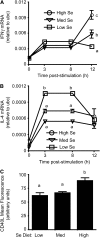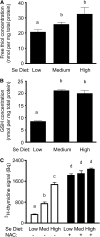Dietary selenium modulates activation and differentiation of CD4+ T cells in mice through a mechanism involving cellular free thiols
- PMID: 20375261
- PMCID: PMC2869499
- DOI: 10.3945/jn.109.120725
Dietary selenium modulates activation and differentiation of CD4+ T cells in mice through a mechanism involving cellular free thiols
Abstract
The immune-enhancing effects of selenium (Se) supplementation make it a promising complementary and alternative medicine modality for boosting immunity, although mechanisms by which Se influences immunity are unclear. Mice fed low (0.08 mg/kg), medium (0.25 mg/kg), or high (1.0 mg/kg) Se diets for 8 wk were challenged with peptide/adjuvant. Antigen-specific CD4(+) T cell responses were increased in the high Se group compared with the low and medium Se groups. T cell receptor signaling in ex vivo CD4(+) T cells increased with increasing dietary Se, with all 3 groups differing from one another in terms of calcium mobilization, oxidative burst, translocation of nuclear factor of activated T cells, and proliferation. The high Se diet increased expression of interleukin (IL)-2 and the high affinity chain of the IL-2 receptor compared with the low and medium Se diets. The high Se diet skewed the T helper (Th)1/Th2 balance toward a Th1 phenotype, leading to higher interferon-gamma and CD40 ligand levels compared with the low and medium Se diets. Prior to CD4(+) T cell activation, levels of reactive oxygen species did not differ among the groups, but the low Se diet decreased free thiols compared with the medium and high Se diets. Addition of exogenous free thiols eliminated differences in CD4(+) T cell activation among the dietary groups. Overall, these data suggest that dietary Se levels modulate free thiol levels and specific signaling events during CD4(+) T cell activation, which influence their proliferation and differentiation.
Figures





Similar articles
-
Effect of dietary selenium and cancer cell xenograft on peripheral T and B lymphocytes in adult nude mice.Biol Trace Elem Res. 2012 May;146(2):230-5. doi: 10.1007/s12011-011-9235-2. Epub 2011 Oct 22. Biol Trace Elem Res. 2012. PMID: 22020772
-
Selenium and immune cell functions. I. Effect on lymphocyte proliferation and production of interleukin 1 and interleukin 2.Proc Soc Exp Biol Med. 1990 Feb;193(2):136-42. doi: 10.3181/00379727-193-43014. Proc Soc Exp Biol Med. 1990. PMID: 2300594
-
Selenium supplementation enhances the expression of interleukin 2 receptor subunits and internalization of interleukin 2.Proc Soc Exp Biol Med. 1993 Mar;202(3):295-301. doi: 10.3181/00379727-202-43538. Proc Soc Exp Biol Med. 1993. PMID: 8437984
-
Selenium and immune function.Z Ernahrungswiss. 1998;37 Suppl 1:50-6. Z Ernahrungswiss. 1998. PMID: 9558729 Review.
-
Selenium and asthma.Mol Aspects Med. 2012 Feb;33(1):98-106. doi: 10.1016/j.mam.2011.10.003. Epub 2011 Oct 15. Mol Aspects Med. 2012. PMID: 22024250 Free PMC article. Review.
Cited by
-
Dietary Selenium Levels Affect Selenoprotein Expression and Support the Interferon-γ and IL-6 Immune Response Pathways in Mice.Nutrients. 2015 Aug 6;7(8):6529-49. doi: 10.3390/nu7085297. Nutrients. 2015. PMID: 26258789 Free PMC article.
-
The hydroxy-analogue of selenomethionine alleviated lipopolysaccharide-induced inflammatory responses is associated with recover expression of several selenoprotein encoding genes in the spleens of Kunming mice.RSC Adv. 2019 Dec 6;9(69):40462-40470. doi: 10.1039/c9ra07260h. eCollection 2019 Dec 3. RSC Adv. 2019. PMID: 35542664 Free PMC article.
-
Selenium and hydrogen selenide: essential micronutrient and the fourth gasotransmitter?Intensive Care Med Exp. 2019 Dec 16;7(1):71. doi: 10.1186/s40635-019-0281-y. Intensive Care Med Exp. 2019. PMID: 31845001 Free PMC article. Review.
-
Can Selenium Reduce the Susceptibility and Severity of SARS-CoV-2?-A Comprehensive Review.Int J Mol Sci. 2022 Apr 27;23(9):4809. doi: 10.3390/ijms23094809. Int J Mol Sci. 2022. PMID: 35563199 Free PMC article. Review.
-
Selenoprotein I deficiency in T cells promotes differentiation into tolerant phenotypes while decreasing Th17 pathology.J Leukoc Biol. 2022 Dec;112(6):1387-1397. doi: 10.1002/JLB.1A0122-080R. Epub 2022 Aug 2. J Leukoc Biol. 2022. PMID: 35916034 Free PMC article.
References
-
- Rayman MP. The importance of selenium to human health. Lancet. 2000;356:233–41. - PubMed
-
- Kryukov GV, Castellano S, Novoselov SV, Lobanov AV, Zehtab O, Guigo R, Gladyshev VN. Characterization of mammalian selenoproteomes. Science. 2003;300:1439–43. - PubMed
-
- Behne D, Wolters W. Distribution of selenium and glutathione peroxidase in the rat. J Nutr. 1983;113:456–61. - PubMed
Publication types
MeSH terms
Substances
Grants and funding
LinkOut - more resources
Full Text Sources
Medical
Molecular Biology Databases
Research Materials

